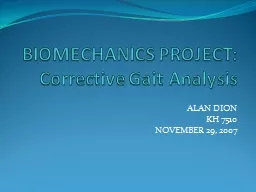

ALAN DION KH 7510 NOVEMBER 29 2007 INTRODUCTION STUDY THE GAIT OF A MAN UNABLE TO READILY DORSIFLEX HIS RIGHT FOOT DUE TO DAMAGE TO CERVICAL AREA AND NERVES HEMIPLEGIA STUDY ALTERNATE ADAPTIVECORRECTIVE GAITS ID: 909703
Download Presentation The PPT/PDF document "BIOMECHANICS PROJECT: Corrective Gait An..." is the property of its rightful owner. Permission is granted to download and print the materials on this web site for personal, non-commercial use only, and to display it on your personal computer provided you do not modify the materials and that you retain all copyright notices contained in the materials. By downloading content from our website, you accept the terms of this agreement.
Slide1
BIOMECHANICS PROJECT:Corrective Gait Analysis
ALAN DION
KH 7510
NOVEMBER 29, 2007
Slide2INTRODUCTION
STUDY THE GAIT OF A MAN UNABLE TO READILY DORSIFLEX HIS RIGHT FOOT DUE TO DAMAGE TO CERVICAL AREA AND NERVES (HEMIPLEGIA)
STUDY ALTERNATE ADAPTIVE/CORRECTIVE GAITS
USING DARTFISH AND FORCE PLATE DATA TO MAKE RECOMMENDATIONS ON PREFERRAL CORRECTIVE GAIT
Slide3INTRODUCTION
USE OF BIOMECHANICS TO CORRECT PATHOLOGICAL BODY MOVEMENTS
CONSIDERABLE RESEARCH ON CORRECTING PATHOLOGICAL GAITS USING PROTHESES AND ORTHOTICS
LESS RESEARCH ON REVISING GAIT ITSELF
Slide4RESEARCH
Chu, T.M & Reddy, N.P. (1995). Stress distribution in the ankle-foot orthosis is used to correct pathological gait.
Journal of Rehabilitation Research and Development
, 32(4), 349-60.
Abnormal motion of the ankle-foot complex is a common problem in stroke victims, who often develop drop foot, involving excessive and uncontrolled plantar flexion. Using an ankle-foot orthosis (AFO) the researchers modeled the GRFs to study the stress distribution in the AFO during the stance phase of gait. Results showed significant stress concentrations in the AFO in heel and neck regions, with maximum compressive stress during heel contact.
Slide5RESEARCH
Burridge, J.H.,
et al.
(2001). Indices to describe different muscle activation patterns, identified during treadmill walking, in people with spastic foot drop.
Medical Engineering & Physics
, 23(6), 427-34.
The study involved individuals unable to dorsiflex due to lesions of CNS, such as hemiplegia following stroke. The researchers tested subjects with hemiplegia against age-matched unimpaired individuals for treadmill walking. Results showed more dissimilarity in calf activation between the impaired and unimpaired subjects in push-off and early stance than in TA during swing, but the hemiplegic subjects lacked the second peak of activity in initial foot contact.
Slide6RESEARCH
Burridge, J.H. & McLellan, D.H. (2000). Relation between abnormal patterns of muscle activation and response to common peroneal nerve stimulation in hemiplegia.
Journal of Neurology, Neurosurgery and Psychiatry
, 69(3), 353-62.
Researchers used functional electrical stimulation of the peroneal nerve in 18 stroke patients with drop foot and 12 unimpaired subjects. Results showed that patients with the worst control of ankle movement had the best improvement, while those with mechanical resistance to passive movement who had more normal activation responded less well. This supported the hypothesis that stimulation of the peroneal nerve to activate TA also inhibits the antagonist calf muscles.
Slide7MEASURES
SUBJECT/PARTICIPANT
Slide8THE PARTICIPANT(S)
STAND-IN
“SUBJECT”
Gender: Male
Age: 56 years
Height: 67 in. (170.2 cm)
Weight: 154 lbs. (70 kg)
Inseam: 29 in. (73.7 cm)
Gender: Male
Age: 81 years
Height: 69.5 in. (176.5 cm)
Weight: 152.5 lbs. (69.3 kg)
Inseam: 30 in. (73.7 cm)
Slide9TEST SUBJECT STAND-IN
Slide10MEASURES
DARTFISH: 2-D video analysis system
Determine stride length and velocity
Force platform strain gauge: force plate
Determine Ground Reaction Forces (GRFs) from footfall impacts
Measure z-axis (vertical forces) in
Newtons
Slide11PROCEDURES
Videotape stand-in participant during normal gait and three corrective/adaptive gaits:
Circumduction
Hip elevation (hip-hitching)
Knee flexion (
steppage
)
Have subject perform all four gaits across force plate in GSU Biomechanics Lab
Slide12RESULTS
NORMAL AND CORRECTIVE GAITS
Slide13NORMAL GAIT: RIGHT FOOT
Slide14NORMAL GAIT: FULL STRIDE
Slide15NORMAL GAIT GROUND REACTION FORCES
LEFT
RIGHT
Slide16CIRCUMDUCTION GAIT
Slide17CIRCUMDUCTION GAIT GRFs
LEFT
RIGHT
Slide18HIP-HITCHING CORRECTIVE GAIT
Slide19HIP-HITCHING GAIT GRFs
LEFT
RIGHT
Slide20KNEE FLEXION CORRECTIVE GAIT
Slide21KNEE FLEXION (STEPPAGE) GRFs
LEFT
RIGHT
Slide22NORMAL GAIT COMPARISONS
Left Step: 0.69 meters
Right Step: 0.66 meters
Stride: 1.35 meters
Speed (ave.): 1.24 meters/second
Average GRF - Left: 369.9 N; Right: 338.1 N
Maximum GRF – Left: 799.8 N; Right: 755.9 N
Sum of GRFs - Left: 221,558.0 N Right: 219,946.2N
Slide23CIRCUMDUCTION GAIT
Left Step: 0.56 meters
Right Step: 0.68 meters
Stride: 1.24 meters
Speed : Left = 1.14 m/s; Right = 0.87 m/s
Average GRF - Left: 312.7 N; Right: 291.4 N
Maximum GRF – Left: 723.0 N; Right: 819.1 N
Sum of GRFs - Left: 314,192.2 N Right: 236,796.4N
Slide24HIP ELEVATION GAIT
Left Step: 0.55 meters
Right Step: 0.72 meters
Stride: 1.28 meters
Speed: Left = 0.92 m/s; Right = 0.90 m/s
Average GRF - Left: 302.4 N; Right: 300.3 N
Maximum GRF – Left: 657.1 N; Right: 770.4 N
Sum of GRFs - Left: 276,430.6 N Right: 257,727.2N
Slide25KNEE FLEXION GAIT (STEPPAGE)
Left Step: 0.55 meters
Right Step: 0.68 meters
Stride: 1.23 meters
Speed: Left = 1.01 m/s; Right = 0.88 m/s
Average GRF - Left: 311.4 N; Right: 258.2 N
Maximum GRF – Left: 739.3 N; Right: 808.7 N
Sum of GRFs - Left: 286,873.8 N Right: 233,959.7N
Slide26DISCUSSION
Slide27PLUSES AND MINUSES FOR ALL
Circumduction has :
Big disparity in velocities, step length, GRFs
Highest overall velocity, so closest to Normal
Hip-hitching has :
Less disparity in velocities and GRFs (ave. & max)
Biggest disparity in step lengths
Knee flexion has :
Big disparities in everything; shortest stride
Lowest Total GRF
Slide28CONCLUSIONS (???)
No single factor dominates
No one of the adaptive gaits is clearly superior
None are similar to the normal gait (
e.g.
left foot GRFs)
Need more research on how to prioritize factors
E.g.
Is lower total GRF more important than max GRF as far as impacts to heel and neck of ankle? Toe off?
Is uniformity of stride more important than velocity?
Slide29SPECIAL THANKS:
Kevin Wasco: Videography & Force plate operation
Dr. Mark Geil: Data retrieval